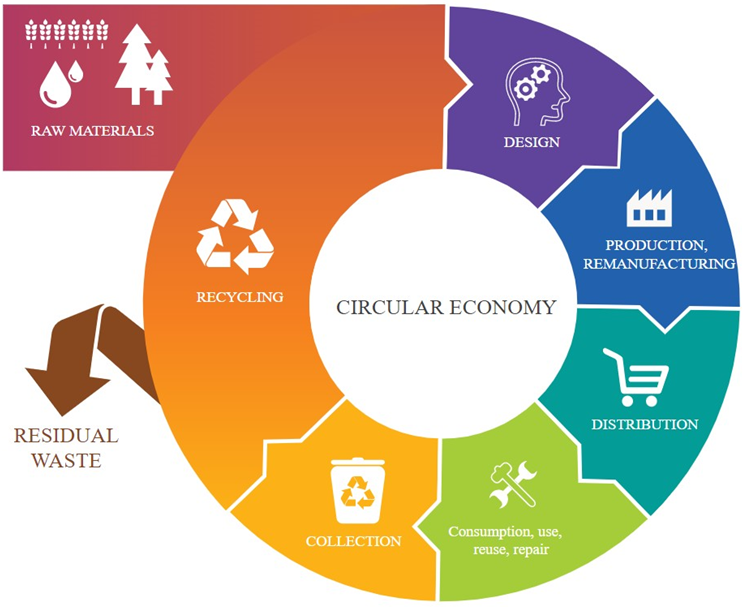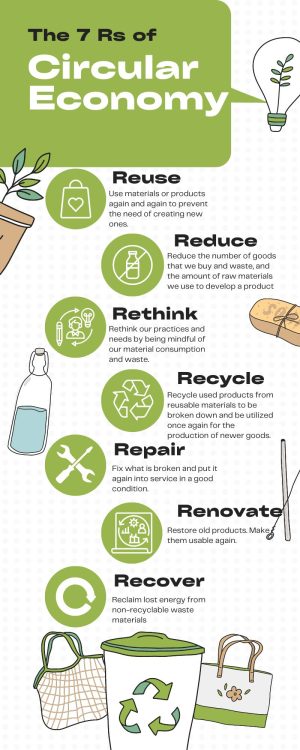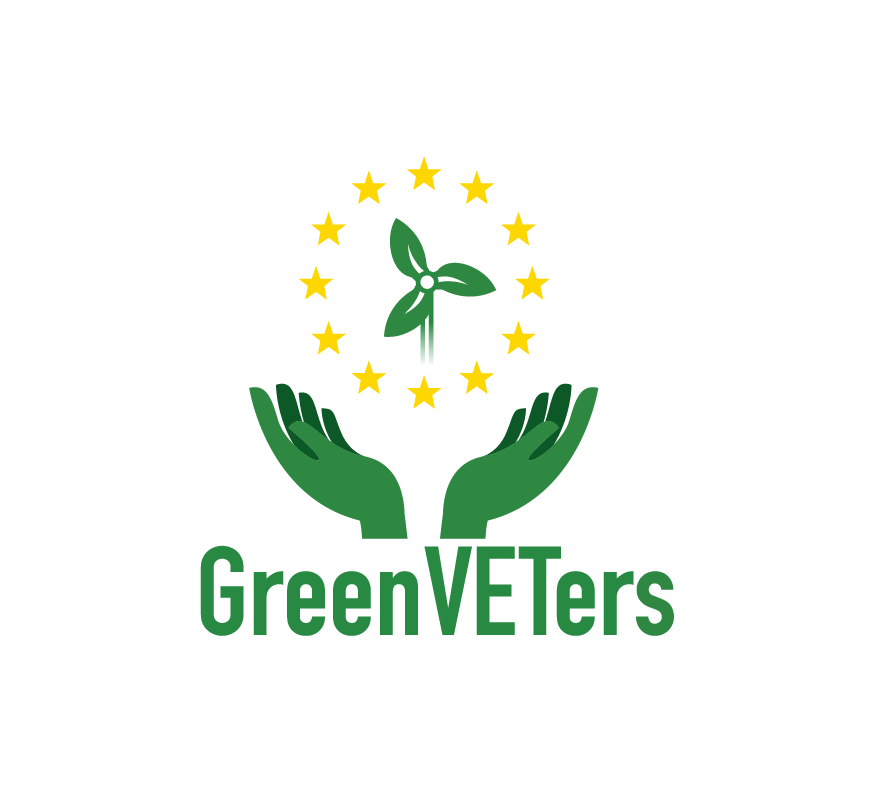WorkSheet for Lesson 3:
Economic Sustainability - Linear Vs CircularEconomies
Learning Objectives:
1. Students learn about the differences between linear and circular economies
2. Students learn about the 7Rs of circular economy
3. Students learn about the ways in which the EGD aims to achieve a sustainable circular European economy
Linear vs. Circular Economy
The economy is key to fighting climate change.That’s why we need to shift from a linear to a circular economy to improve society and become more environmentally friendly. But what are the differences between these two terms?
Linear economy:
This economic model was utilized by the developed industrial economies of the 20th century. It frequently follows the “take-make-waste” pattern. To put it more precisely, it means that raw materials are first collected, then processed into products, and finally, after being consumed or used, the products are disposed of as waste. With products made to be thrown away once they’ve been used, profit comes first before sustainability.
Circular economy:
As it became clear that the linear model could not support infinite economic growth on the planet’s finite resources, the circular economic model of production was introduced as a challenge to the conventional one. By designing a system that uses “waste,” the circular approach detaches economic activity from its reliance on limited resources. The materials are wasted and not disposed of in this way.Instead, they rejoin the cycle of production, ensuring sustainability and reducing the negative impact on the environment. It is intended for the system to regenerate itself.This model aims to extend the life cycle of products to use them in the best way possible for minimal environmental impact.
The 7R’s of Circular Economy
Reuse:
Over time, many products can be used in multiple applications. Even if the original customer no longer requires a product due to a change in circumstances or because he no longer desires it, there is a good chance that the product will still be in good enough condition to allow for new use by someone else. This philosophy is apparent in individuals who donate clothes or furniture, instead of throwing them out,and in people who frequently visit second-hand shops.
Recycle:
Reintroducing waste that has already been used up in a production process allows it to be utilized as a raw material once more for the creation of new goods.Recycling offers a plethora of opportunities and excellent resource optimization. For example, glass that is placed in a recycling bin is sorted by colour and cleaned in a glass treatment facility. The material is then broken down, melted, and turned into fresh goods like bottles that are ready for reuse.
Reduce:
Reduce can be applied in two ways:
- For the consumers: we buy a lot, consume a lot, and throw away a lot. A good way of taking care of the environment is to reduce the number of products that we buy and waste.
- Reducing the number of raw materials used to develop a product is the meaning of the term “reduce” at the industrial level. This can be accomplished by consider ingnon-essential product characteristics, such as packaging, avoiding plastic bags, etc.
Rethink:
Rethink, or redesign is about considering the environment and ecology. It is not only about functionalities but also about the raw material, the packaging, etc.
Repair:
Repair is simply about fixing what is broken and putting it again into service in good condition. It is simple and efficient. It’s all about reducing the tendency of throwing away damaged products. Most of the time, a product has the capacity to serve its purpose for a far greater time frame, if its user bothers to repair it. This is especially true about electric and electronic devices since with the replacement of only a single component, their life span can massively increase.
Renovation/Renewal/Refurbish:
You don’t need to buy everything brand-new, and vintage is the new trend. Why then not follow the movement? Refurbishing typically refers to renovating a building’s older spaces. The principle of renovation and renewal refers to the restoration of older products such as furniture, and cars to make them usable again. It doesn’t only help the planet; it helps us as well. Renovating a productor space exponentially increases its monetary value.
Recovery:
Recovery places more of an emphasis on available resources. In recovery,people use waste as an input source to produce new, useful products. The goal is to minimize waste production to maximize waste value and reduce the need for land fillspace. A great example of this practice is the usage of old, used cooking oil as fuel or utilizing the exothermic properties of composting organic waste to create heat.
How to achieve a sustainable Circular European Economy?
The new Circular Economy Action Plan (CEAP) was approved by the European Commission in March 2020. It is one of the main pillars of the European Green Deal,the continent’s new plan for sustainable development. The EU’s transition to a circular economy will relieve the pressure on the planet’s natural resources and create employment and sustainable growth. The main points of CEAP are explained below.
Firstly, the European Commission will propose a new legislative action aiming to ensure the design of sustainable products to make them ‘suitable for a climate-neutral,resource-efficient circular economy’. Secondly, the Green Deal action plan aims to empower consumers by making sure that they receive accurate and relevant information about any product’s ‘lifespan, availability of repair services, spare parts and repair manuals.’ Furthermore, the Commission will enable greater circularity in the industrial section by integrating circular economic practices, facilitating industrial symbiosis, promoting the adoption of ‘green technologies’ and encouraging the usage of digital technologies for tracking, tracing and mapping of resources.
To tackle the fast-growing waste stream of electronics within the EU, the Commission will present a ‘Circular Electronics Initiative’. This initiative will ensure energy efficiency,durability, reparability, upgradability, maintenance, reuse, and recycling of electronic devices. A new regulatory framework for batteries will also be introduced improving the existing rules on the recycling of batteries. What is more, it will address the issue of non-rechargeable batteries and enforce sustainability and transparency requirements for batteries.
The Green Deal action plan also includes efforts to reduce over-packaging by issuing essential requirements and limiting package waste by mandating the creation of reusable and recyclable packages. The Commission plans on reducing the amount of microplastics in the environment by limiting their use and forcing requirements for recycled content in key plastic products. In the field of textiles, the Commission will propose a ‘comprehensive EU Strategy for Textiles’. This strategy will aim at strengthening innovation, and boosting the market for sustainable and circular textiles while also addressing the issue of fast fashion.
To increase the material efficiency and to reduce the climate impact of the construction industry the Commission will launch its ‘Strategy for a Sustainable Built Environment.’ This Strategy will ensure energy and resource efficiency, in addition to proper management of construction and demolition waste.
Additionally, special attention is given to the necessity of stopping the loss of biodiversity and reaching the EU’s 2050 climate neutrality goal.


REFERENCES
https://www.researchgate.net/publication/318183876_Linear_Economy_Versus_Circular_Economy_A_Comparative_and_Analyzer_Study_for_Optimization_of_Economy_for_Sustainability
https://environment.ec.europa.eu/strategy/circular-economy-action-plan_en
https://medium.com/@beta__i/the-7-rs-of-the-circular-economy-11d27e933f01
https://www.europarl.europa.eu/news/en/headlines/economy/20151201STO05603/circular-economy-definition-importance-and-benefits
https://eur-lex.europa.eu/resource.html?uri=cellar:9903b325-6388-11ea-b735-01aa75ed71a1.0017.02/DOC_1&format=PDF
Secretary-General of the European Commission, signed by Mr Jordi AYET PUIGARNAU,Director. “A New Circular Economy Action Plan For a Cleaner and More Competitive Europe.” Consilium, Council of the European Union, 6 Oct. 2022,
https://www.consilium.europa.eu/en/documents-publications/
.
It's Quiz Time!
It’s quiz time!
Here’s a fun quiz that you could use to test your understanding of the key concepts covered in this lesson:
Quiz Summary
0 of 3 Questions completed
Questions:
Information
You have already completed the quiz before. Hence you can not start it again.
Quiz is loading…
You must sign in or sign up to start the quiz.
You must first complete the following:
Results
Results
0 of 3 Questions answered correctly
Your time:
Time has elapsed
You have reached 0 of 0 point(s), (0)
Earned Point(s): 0 of 0, (0)
0 Essay(s) Pending (Possible Point(s): 0)
Categories
- Not categorized 0%
- 1
- 2
- 3
- Current
- Review
- Answered
- Correct
- Incorrect
-
Question 1 of 3
1. Question
What is the difference between a linear and circular economy?
CorrectIncorrect -
Question 2 of 3
2. Question
What are the 7Rs of circular economy?
CorrectIncorrect -
Question 3 of 3
3. Question
How can we achieve a sustainable circular European economy?
CorrectIncorrect





